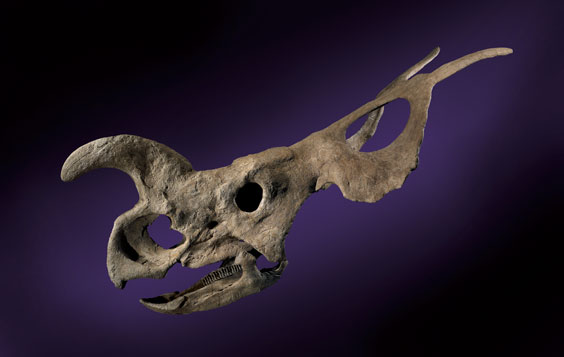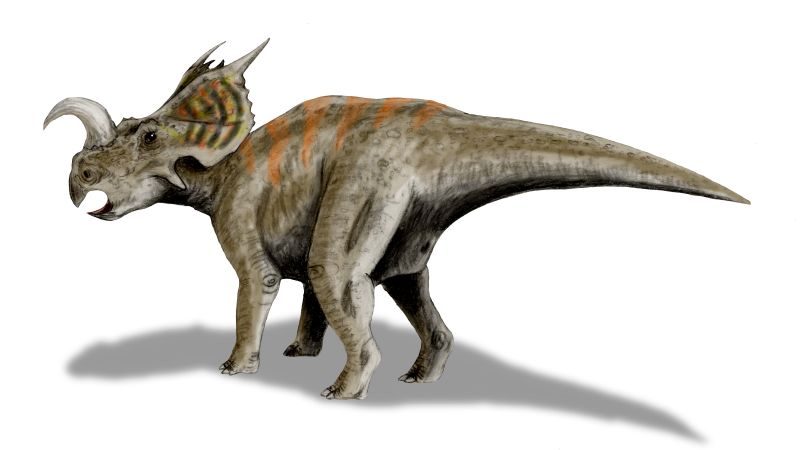

Einosaur Original Fossils for sale
Einiosaurus fossils and cast replicas for sale. (pronounced eye-nee-oh-SAWR-us)


Einiosaurus is a medium-sized centrosaurine (“short-frilled”) ceratopsian from the Upper Cretaceous (Campanian) Two Medicine Formation of northwestern Montana. The generic epithet means 'buffalo lizard', in a combination of Blackfeet Indian and Latinized Ancient Greek and the specific epithet means 'forward-curving horn' in Latin and Ancient Greek.
Fossil Material Einiosaurus is an exclusively Montanan dinosaur, and all its known remains are currently held at the Museum of the Rockies in Bozeman, Montana. At least 15 individuals of varying ages are represented by three adult skulls and hundreds of other bones from two low-diversity (in species) bonebeds, which were discovered by Jack Horner in 1985 and excavated from 1985 - 1989 by Museum of the Rockies field crews. These bonebeds were originally thought to contain a new species of Styracosaurus and are referred to as such in the comprehensive taphonomic study by Ray Rogers (1990).
Description In 1995 Scott D. Sampson formally described and named Einiosaurus procurvicornis from this material, as well as Achelousaurus horneri, also from a bonebed in this region. Einiosaurus is typically portrayed with a low, strongly forward-curving nasal horn that resembles a bottle opener, though this may only occur in some adults. Supraorbital (over-the-eye) horns are low and rounded if present at all, as opposed to ceratopsids with prominent supraorbital horns such as Triceratops. A pair of large spikes projects
Taphonomy and paleobiology Low-diversity and monospecific bonebeds are thought to represent herds that may have died catastrophically, such as during a drought or flood. This is evidence that Einiosaurus, as well as other centrosaurine ceratopsians such as Pachyrhinosaurus and Centrosaurus, were gregarious, herding animals similar in behavior to modern-day bison or wildebeest. In contrast, chasmosaurine (“long-frilled”) ceratopsids, such as Triceratops and Torosaurus, are typically found singly, implying that they may have been somewhat solitary in life, though fossilized footprints may provide evidence for the contrary.
Einiosaurus was a herbivorous dinosaur and grew to 6 meters in length. Like all ceratopsids, it had a complex dental battery capable of processing even the toughest plants. Contemporaneous dinosaurs include the basal ornithopod Orodromeus, the hadrosaurids Hypacrosaurus, Maiasaura, and Prosaurolophus; ankylosaurs Edmontonia and Euoplocephalus, the tyrannosaurid Daspletosaurus (which appears to have been a specialist of preying on ceratopsians), as well as the smaller theropods Bambiraptor, Chirostenotes, Troodon, and Avisaurus; and the ceratopsids Brachyceratops and Achelosaurus. Einiosaurus lived in a climate that was seasonal, warm, and semi-arid. Other fossils found with the Einiosaurus material include freshwater bivalves and gastropods, which imply that these bones were deposited in a shallow lake environment.
Phylogeny The placement of Einiosaurus within Centrosaurinae is problematic due to the transformational nature of several of its skull characters, and its closest relatives are either Centrosaurus and Styracosaurus or Achelousaurus and Pachyrhinosaurus. The latter hypothesis is supported by Horner et al. (1992), where Einiosaurus is the earliest of a transformational series in which the nasal horns gradually change to rugose bosses, as in Achelousaurus and Pachyrhinosaurus who are the second and third in this series. The frills also grow in complexity.
Regardless of which hypothesis is correct, Einiosaurus appears to occupy an intermediate position with respect to the evolution of the centrosaurines.
References Dodson, P., C.A. Forster, and S.D. Sampson. 2004. "Ceratopsidae" in Weishampel, D.B., P. Dodson, and H. Osmolska (eds.) The Dinosauria. 2nd Edition, University of California Press.
Horner, J.R., D.J. Varricchio, and M.J. Goodwin. 1992. "Marine transgressions and the evolution of Cretaceous dinosaurs". Nature 358:59-61.
Rogers, R.R. 1990. "Taphonomy of three dinosaur bone beds in the Upper Cretaceous Two Medicine Formation of northwestern Montana: evidence for drought-related mortality". Palaios 5:394-413.
Sampson, S.D. 1995. "Two new horned dinosaurs from the Upper Cretaceous Two Medicine Formation of Montana; with a phylogenetic analysis of the Centrosaurinae (Ornithischia: Ceratopsidae)". J. Vert. Paleontol. 15(4):743-760.
Kingdom: Animalia Phylum: Chordata Class: Sauropsida Superorder: Dinosauria Order: Ornithischia Family: Ceratopsidae Subfamily: Centrosaurinae Genus: Einiosaurus Sampson, 1995